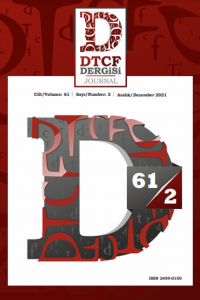Abstract
Mazhar ul Islam is one of the leading authors of contemporary Urdu literature. Due to the romantic, realist, surrealist, and symbolist concepts used in his works, the author's style, which allows contrasting or incompatible interpretations to be harmonized, is described as his most important feature. The events and characters in the stories of Mazhar ul Islam are generally a literary reflection of Pakistani society. At the same time, the author does not hesitate to bring the traces of his inner world to the reader. While reflecting local feelings and events in his works, Mazhar ul Islam mostly uses trend literary structures in world literature as a tool and indirectly contributes to the universalization process of Urdu literature. The main literary feature of the author is that he has a style of writing that transforms reality into mystery and then brings the real meaning of the mysterious with reality, allowing the cognitive process to begin without time and space. The works of the author are in the form of documents of his life, and therefore the emotional experiences that penetrated his soul, the stages he passed and the worldly issues he observed form the basis of his literary technique. The unconditional harmony arising from freedom, opposition and contrasts in the author's narrative is nourished by these contrasting life experiences. In this study, basic information about Mazhar ul Islam's life and career have been tried to be presented and the author's stories have been tried to be analyzed in a thematic context.
Keywords
References
- Asad A.H. (2010). Interwiew: Mazhar ul Islam. Date of Access: 10.03.2020, https://newslinemagazine.com/magazine/interview-mazharul-islam/
- Ashraf, A.B. (2009). Shaıroon aor afsana Nigaroon ka Mutalıa. Lahore: Sang-e Meel Publications.
- Ashraf, A.B. (1987). Kuçh Nei aor Purane Efsane Nigar. Lahore: Sang-e Meel Publications.
- Hussain, J. (2017). A History of the Peoples of Pakistan Towards Independence. Karachi: Oxford University Press.
- Islam, M. (1989). Ghoron ke Şeher mein Akela Admi. Lahore: Sang-e Meel Publications.
- Islam, M. (1991). Khat mein Post ki hue Dopher. Lahore: Sang-e Meel Publications.
- Islam, M. (2012a). Baton ki Bariş mein Bhegti Lerki. Islamabad: Leo Books.
- Islam, M. (2012b). The Season of Love Bitter Almonds and Delayed Rains (Christopher Schackle, Trans.). Islamabad: Leo Books.
- Islam, M. (2012c). Mein Aap aor Voh. Islamabad: Leo Books..
- Islam, M. (2012d). La stagione dell’amore, delle mandorle amare e delle piogge tarde (Sabrina Lei Chalikandi, Trans.). Jay editor.
- Islam, M. (2012e). Gurya ki Ankh se Şeher ko Deykho. Islamabad: Leo Books.
- Islam, M. (2012f). Ghoron ke Şeher mein Akela Admi. Islamabad: Leo Books.
- Malik, F.M. (2013). Ataş-i Rafta ka Surağ. Islamabad: National Book Foundation.
- Nashtar, M.G. (2016). Mazhar ul Islam ka Fiction. Delhi: Kitab Dunya.
- Soydan, C. (2018). Pakistan Hindistan Öyküleri. Ankara: Hece Yayınları.
- Syed, F. (2013). Naqoosh-e Adab. Lahore: Sang-e Meel Publications.
- Wellek, R., Warren, A. (1983). Edebiyat Biliminin Temelleri (Prof.Dr. Ahmet Edip Uysal, Çev.). Ankara: Başbakanlık Basımevi.
Abstract
Mazhar ul İslam, çağdaş Urdu edebiyatının önde gelen yazarlarından biridir. Eserlerinde kullandığı romantik, realist, sürrealist ve sembolist kavramlardan dolayı, yazarın zıt ya da uyumsuz yorumların uyumlu hale getirilmesine olanak sağlayan üslubu, yazarın en önemli özelliği olarak tanımlanır. Mazhar ul İslam’ın öykülerindeki olaylar ve karakterler genellikle Pakistan toplumunun edebi bir yansımasıdır. Aynı zamanda yazar kendi iç dünyasının izlerini okuyucuya taşımaktan da çekinmez. Mazhar ul İslam, yerel duygu ve olayları eserlerine yansıtırken, çoğu zaman dünya edebiyatındaki popüler edebi yapıları bir araç olarak kullanır ve Urdu edebiyatının evrenselleşme sürecine dolaylı olarak katkıda bulunur. Yazarın temel edebi özelliği, gerçekliği gizeme dönüştüren ve ardından gizemli olanın gerçek manasını hakikatle buluşturan, zamansız ve mekânsız bilişsel sürecin başlamasına izin veren bir yazım tarzına sahip olmasıdır. Müellifin eserleri, hayatının vesikalarıdır ve bu nedenle, ruhuna işleyen duygusal tecrübeler, geçirdiği evreler ve gözlemlediği dünyevî meseleler onun edebî tekniğinin temelini oluşturur. Yazarın anlatısındaki özgürlük, muhalefet ve zıtlıklardan doğan ön koşulsuz uyum, bu kontrast yaşam deneyimlerinden beslenir. Bu çalışmada Mazhar ul İslam'ın hayatı ve kariyeri hakkında temel bilgiler sunulmaya çalışılmış ve yazarın öyküleri tematik bir bağlamda analiz edilmeye çalışılmıştır.
Keywords
References
- Asad A.H. (2010). Interwiew: Mazhar ul Islam. Date of Access: 10.03.2020, https://newslinemagazine.com/magazine/interview-mazharul-islam/
- Ashraf, A.B. (2009). Shaıroon aor afsana Nigaroon ka Mutalıa. Lahore: Sang-e Meel Publications.
- Ashraf, A.B. (1987). Kuçh Nei aor Purane Efsane Nigar. Lahore: Sang-e Meel Publications.
- Hussain, J. (2017). A History of the Peoples of Pakistan Towards Independence. Karachi: Oxford University Press.
- Islam, M. (1989). Ghoron ke Şeher mein Akela Admi. Lahore: Sang-e Meel Publications.
- Islam, M. (1991). Khat mein Post ki hue Dopher. Lahore: Sang-e Meel Publications.
- Islam, M. (2012a). Baton ki Bariş mein Bhegti Lerki. Islamabad: Leo Books.
- Islam, M. (2012b). The Season of Love Bitter Almonds and Delayed Rains (Christopher Schackle, Trans.). Islamabad: Leo Books.
- Islam, M. (2012c). Mein Aap aor Voh. Islamabad: Leo Books..
- Islam, M. (2012d). La stagione dell’amore, delle mandorle amare e delle piogge tarde (Sabrina Lei Chalikandi, Trans.). Jay editor.
- Islam, M. (2012e). Gurya ki Ankh se Şeher ko Deykho. Islamabad: Leo Books.
- Islam, M. (2012f). Ghoron ke Şeher mein Akela Admi. Islamabad: Leo Books.
- Malik, F.M. (2013). Ataş-i Rafta ka Surağ. Islamabad: National Book Foundation.
- Nashtar, M.G. (2016). Mazhar ul Islam ka Fiction. Delhi: Kitab Dunya.
- Soydan, C. (2018). Pakistan Hindistan Öyküleri. Ankara: Hece Yayınları.
- Syed, F. (2013). Naqoosh-e Adab. Lahore: Sang-e Meel Publications.
- Wellek, R., Warren, A. (1983). Edebiyat Biliminin Temelleri (Prof.Dr. Ahmet Edip Uysal, Çev.). Ankara: Başbakanlık Basımevi.
Details
| Primary Language | English |
|---|---|
| Subjects | Language Studies, Creative Arts and Writing |
| Journal Section | Research Article |
| Authors | |
| Publication Date | December 28, 2021 |
| Submission Date | September 4, 2021 |
| Published in Issue | Year 2021 Volume: 61 Issue: 2 |
Ankara University Journal of the Faculty of Languages and History-Geography
This journal is licensed under the Creative Commons Attribution-NonCommercial 4.0 International License.


